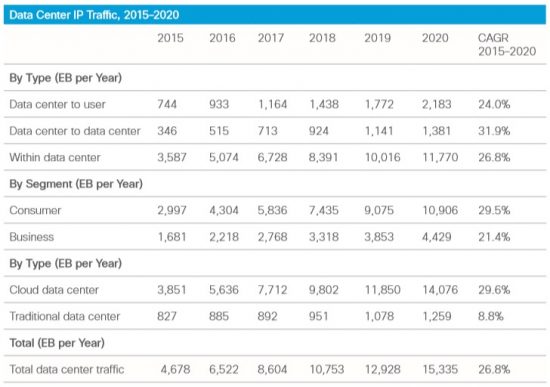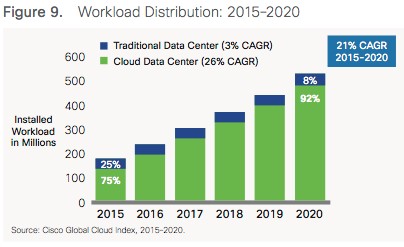We’re at the cusp of a cloud data transformation, and there shouldn’t be any doubt that the cloud is going to take center stage in your data center planning.
Over the last few years, cloud adoption has evolved from an emerging technology to an established networking solution that is gradually gaining acceptance in enterprises.
When Cisco first launched its first Global Cloud Index report in 2015, we predicted that in four years, cloud traffic would account for most data center network traffic with the majority of workloads migrating to the cloud.


Our latest Cloud Index report, released earlier this month, continues to affirm this inexorable shift. From 2015 to 2020, cloud data center traffic will grow at a clip of about 30% year on year (see above charts). By 2020, the cloud will outpace traditional center growth with 92 per cent of workloads (see below workload distribution) processed by cloud data centers, data stored in data centers will quintuple by 2020 and 68 percent of the cloud workloads will be in public cloud data centers.

What the numbers also indicate is that the cloud is becoming an essential scalable and flexible part of architecture for service providers of all types around the world.
We can expect network cloud traffic to double or treble each year for the next few years as service providers continue to simplify their technology infrastructures to achieve greater operational flexibilities and deliver more flexible services.
By 2020, Cisco’s Global Cloud index predicts that almost half of traffic, or 44 percent, within data centers will be supported by SDN/NFV platforms as operators strive for greater efficiencies. SDN and NFV will help to flatten data center architectures and simplify traffic flows. Nearly 60 percent of global hyperscale data centers are expected to deploy SDN/NFV solutions.
With global IT spending becoming more cautious, many enterprises and service providers today need to balance between tight capital budgets, little or no head count growth and cope with a rising demand for IT services.
They need to revamp their business models and find new ways to automate processes, look for additional revenue streams, increase productivity, and scale resources up and down dynamically as the market requires.
As more organizations move to cloud and hybrid architectures, integrating their data center and cloud strategies will be critical to their IT transformation.
The question you need to ask is how the network infrastructure can deliver the agility and speed for their business to remain competitive?
By the end of 2017, Gartner predicts that nearly half of enterprise will have deployed a hybrid cloud environment. IDC in the same vein says 60% to 70% of enterprises’ IT infrastructure and software investments will be cloud based (private and public) by 2020.
I believe that the future will see a mix of workloads, with applications and data strung across public and private clouds as well as traditional on-premise, and hybrid infrastructures becoming an efficient way to host large applications in the cloud. When we shift from traditional to the cloud data center, IT needs to be provisioned as a service and be consumed only when required.
The signs are already there. Earlier this year, Netflix announced plans to shut down the last of its traditional data centers, a move that will make it one of the first of large global organizations to run all of its IT in the public cloud.
In time, we foresee a vibrant marketplace of clouds, and envision that there will be different types of clouds (public, private, virtual, and inter-clouds), and many different services (software, platform, and infrastructure) co-existing and delivered via the cloud.
To stay ahead, you need to ready your datacenter for a multicloud world.
Please watch our recent webinar here on the Global Cloud Index for APJ market.

CONNECT WITH US